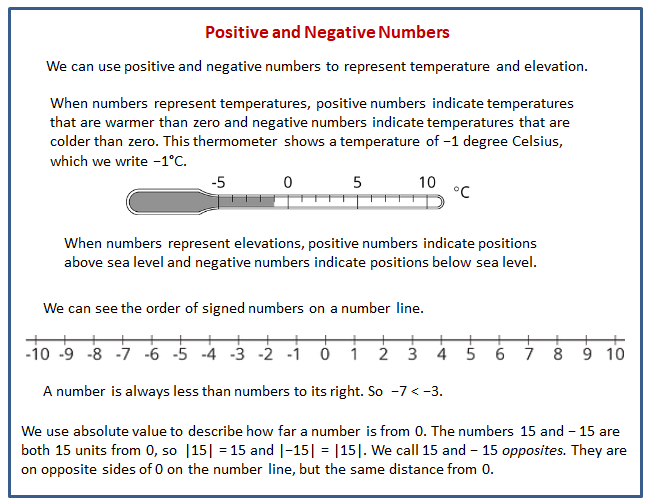Illustrative Mathematics Grade 7, Unit 5, Lesson 1: Interpreting Negative Numbers
Learning Targets:
- I can compare rational numbers.
- I can use rational numbers to describe temperature and elevation.
Related Pages
Illustrative Math
Grade 7
Lesson 1: Interpreting Negative Numbers
Let’s review what we know about signed numbers.
Illustrative Math Unit 7.5, Lesson 1 (printable worksheets)
Lesson 1 Summary
The following diagram shows how to use positive and negative numbers to describe temperature and elevation.

Lesson 1.1 Using the Thermometer
Here is a weather thermometer. Three of the numbers have been left off.
- What numbers go in the boxes?
- What temperature does the thermometer show?
Lesson 1.2 Fractions of a Degree
- What temperature is shown on each thermometer?
- Which thermometer shows the highest temperature?
- Which thermometer shows the lowest temperature?
- Suppose the temperature outside is -4°C. Is that colder or warmer than the coldest temperature shown? How do you know?
Lesson 1.3 Seagulls Soar, Sharks Swim
Here is a picture of some sea animals. The number line on the left shows the vertical position of each animal above or below sea level, in meters.
- How far above or below sea level is each animal? Measure to their eye level.
- A mobula ray is 3 meters above the surface of the ocean. How does its distance from the surface of the ocean compare to the vertical distance from the eyes of:
The jumping dolphin?
The flying seagull?
The octopus? - An albatross is 5 meters above the surface of the ocean. How does its distance from the surface compare to the vertical distance from the eyes of:
The jumping dolphin?
The flying seagull?
The octopus? - A clownfish is 2 meters below the surface of the ocean. How does its distance from the surface compare to the vertical distance from the eyes of:
The jumping dolphin?
The flying seagull?
The octopus? - The vertical distance of a new dolphin from the dolphin in the picture is 3 meters. What is its distance from the surface of the ocean?
Are you ready for more?
The north pole is in the middle of the ocean. A person at sea level at the north pole would be 3,949 miles from the center of the earth. The sea floor below the north pole is at an elevation of approximately -2.7 miles. The elevation of the south pole is about 1.7 miles. How far is a person standing on the south pole from a submarine at the sea floor below the north pole?
-
Show Answer
The distance from the sea floor below the north pole to the center of the earth is 3,949 - 2.7 = 3,946.3 miles.
The distance from the elevation of the south pole to the center of the earth is 3,949 + 1.7 = 3,950.7 miles.
The distance from a person standing on the south pole from a submarine at the sea floor below the north pole is 3,946.3 + 3,950.7 = 7897 miles.
Lesson 1 Practice Problems
- It was -5°C in Copenhagen and -12°C in Oslo. Which city was colder?
- a. A fish is 12 meters below the surface of the ocean. What is its elevation?
b. A sea bird is 28 meters above the surface of the ocean. What is its elevation?
c. If the bird is directly above the fish, how far apart are they? - Compare using >, =, or <.
a. 3 _____ -3
b. 12 _____ 24
c. -12 _____ -24
d. 5 _____ -(-5)
e. 7.2 _____ 7
f. -7.2 _____ -7
g. -1.5 _____ -3/2
h. -4/5 _____ -5/4
i. -3/5 _____ -6/10
j. -2/3 _____ 1/3 - Han wants to buy a $30 ticket to a game, but the pre-order tickets are sold out. He knows there will be more tickets sold the day of the game, with a markup of 200%. How much should Han expect to pay for the ticket if he buys it the day of the game?
- A type of green paint is made by mixing 2 cups of yellow with 3.5 cups of blue.
a. Find a mixture that will make the same shade of green but a smaller amount.
b. Find a mixture that will make the same shade of green but a larger amount.
c. Find a mixture that will make the different shade of green that is bluer.
d. Find a mixture that will make the different shade of green that is more yellow.
The Open Up Resources math curriculum is free to download from the Open Up Resources website and is also available from Illustrative Mathematics.
Try out our new and fun Fraction Concoction Game.
Add and subtract fractions to make exciting fraction concoctions following a recipe. There are four levels of difficulty: Easy, medium, hard and insane. Practice the basics of fraction addition and subtraction or challenge yourself with the insane level.

We welcome your feedback, comments and questions about this site or page. Please submit your feedback or enquiries via our Feedback page.